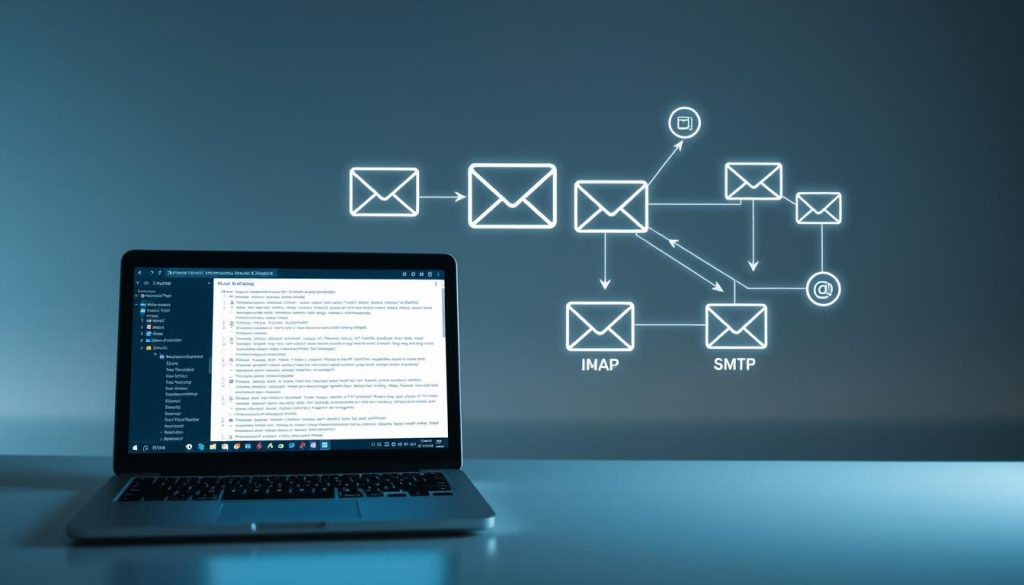Email communication uses protocols like IMAP and POP3. These protocols help manage email headers. Knowing them is key for good email management.
Learning about email headers lets users see who sent and received emails. They can also see when emails were sent and how they were routed. This helps spot security risks and solve problems.
Key Takeaways
- IMAP and POP3 are crucial protocols for email communication.
- Email headers contain vital information about email communication.
- Analyzing email headers can help identify security threats.
- Mastering email headers is essential for effective email management.
- Understanding IMAP and POP3 protocols is vital for email clients.
The Fundamentals of Email Communication
Sending and getting emails is a complex process. It involves many protocols and servers. This infrastructure helps messages travel all over the world.
How Emails Travel Across the Internet
Emails move through the internet using servers and protocols. SMTP (Simple Mail Transfer Protocol) is key in this journey.
SMTP’s Role in Email Transmission
SMTP helps send emails from one server to another. It makes sure emails reach the right server.
The Client-Server Email Architecture
The client-server setup is the base of email. Tools like Microsoft Outlook or Mozilla Thunderbird talk to servers. They send and get emails.
The Role of Email Protocols in Message Delivery
Email protocols like SMTP, IMAP (Internet Message Access Protocol), and POP3 (Post Office Protocol version 3) help emails get through. They work together for email communication.
Protocol Interactions in a Complete Email Journey
Protocols must work well for email to be delivered. SMTP sends emails. IMAP or POP3 gets them from the server.
| Protocol | Role in Email Communication |
|---|---|
| SMTP | Relays emails between servers |
| IMAP | Retrieves emails from a server, allowing for synchronization across multiple devices |
| POP3 | Retrieves emails from a server, typically downloading them to a single device |
What Are Email Headers?
Email headers are key to knowing how emails get sent and received. They hold important info about the email’s journey, like where it started and where it’s going.
The Anatomy of an Email Message
An email has two main parts: the header and the body. The header section has details about the email. The body section is where the message is.
Header Section vs. Body Section
The header shows who sent and who got the email, the subject, and when. The body is where you find the email’s content, like text or pictures.
MIME Headers and Multipart Messages
MIME headers help with messages that have different types of content, like text and images. They tell email clients how to show these messages right.
Visible vs. Hidden Header Information
Email headers have info that’s seen and info that’s not. Some, like the subject and who sent it, are easy to see. But other details are hidden.
Why Most Headers Are Hidden by Default
Most headers are hidden because they have tech details that most people don’t need. But, knowing about email headers is important for tasks like email header extraction. It’s also key for fixing email problems, especially with imap email header management.
Common Email Header Fields Explained
Email headers are key to knowing how emails move around. They tell us how emails are sent and received. This is important for understanding POP3.
From, To, Subject, and Date Fields
The From, To, Subject, and Date fields are basic in an email header. They show who sent the email and who got it. They also tell us the email’s subject and when it was sent.
Format and Encoding Standards
Email headers have rules to work with all email clients and systems. Knowing these rules helps us email header decoding and fix email problems.
Message-ID, References, and In-Reply-To
Fields like Message-ID, References, and In-Reply-To are important for email threading. They help group emails that are part of the same conversation.
How Threading Works Through Headers
These fields help email clients link emails together. This makes it easier to follow conversations in emails.
Received Headers and Their Significance
Received headers show each server that handled the email. They help us see where the email came from. This is useful for fixing pop3 email header issues.
Reading the Email’s Journey Through Received Headers
Looking at Received headers lets us see where the email went. We can see which servers it passed through and when. This helps us find and fix email delivery problems.
Understanding Email Header Using IMAP and POP3
IMAP and POP3 are key to how emails work. They show where emails come from and where they go. Each protocol changes how we see and manage emails.
How Protocols Affect Header Information
IMAP and POP3 change how we see email headers. IMAP lets us get specific header info. POP3 brings the whole email, including headers, to our device.
Protocol-Specific Header Modifications
Some email systems change headers based on the protocol. They might add info to show how the email was sent. Experts say, “Keeping email headers right is key for safe and correct email use.”
“The way email headers are handled can significantly impact email security and authentication mechanisms.”
Header Preservation Across Different Protocols
Keeping email headers the same across protocols is important. This keeps email messages clear and safe. When we switch protocols, we must keep header info safe.
Ensuring Header Integrity During Protocol Transitions
Email clients and servers need to handle protocol changes well. They should use special commands to keep header info safe. Knowing how to handle email headers across protocols is very important.
POP3 Protocol: A Comprehensive Overview
POP3 has grown a lot since it started. It’s now a key way to get emails from a server. It uses TCP/IP to connect and get messages.
History and Development of POP3
POP3 began early in email history. It came from an older POP protocol. It got better and became POP3, which we use today.
Basic Functionality and Commands
POP3 lets users get emails from a server. It uses commands to do this.
POP3 Connection Lifecycle
A POP3 session has a few steps. First, you connect. Then, you log in. Next, you manage your emails. Finally, you update your account.
Common POP3 Command Sequences
POP3 uses commands like USER, PASS, STAT, LIST, RETR, and DELE. These help you handle your emails on the server.
| Command | Description |
|---|---|
| USER | Specify the username |
| PASS | Authenticate with password |
| STAT | Get the number of messages and total size |
POP3 commands are simple. This makes it easy for users to manage their emails. Its simplicity is a big plus.
How POP3 Handles Email Headers
POP3 handles email headers in a special way. It has good points and not-so-good points. Email clients use special commands to get and manage these headers.
Header Retrieval in POP3
In POP3, the TOP command lets you get parts of messages. This means you can see email headers without getting the whole message. It’s great for looking at emails quickly or getting certain info.
The TOP Command for Partial Message Retrieval
The TOP command gets you the headers and a few lines from the email’s body. For example, TOP 1 0 gets the first message’s headers without any body lines.
Retrieving Headers Without Bodies
To get just headers, POP3 clients use the TOP command in a special way. This makes getting header info fast and easy.
| Command | Description |
|---|---|
| TOP 1 0 | Retrieve headers of the first message |
| TOP 2 5 | Retrieve headers and 5 lines of the body of the second message |
Limitations of Header Management in POP3
POP3 has its downsides for handling email headers. It’s made for simple email getting and deleting, not for complex header work.
Why POP3 Falls Short for Advanced Header Analysis
POP3’s simplicity is its main problem. It lacks the tools for detailed header work. For more advanced header analysis, IMAP might be better.
IMAP Protocol: In-Depth Exploration
Exploring the IMAP protocol shows its strong points in email management. It’s better than older protocols like POP3. IMAP makes handling emails more advanced.
Evolution and Advantages of IMAP
The IMAP protocol has grown a lot. It has more benefits than POP3. It lets you manage emails on the server. This makes it easy to sync emails across different devices.
Core Features and Command Structure
IMAP has a strong command structure. It has commands for picking mailboxes, getting message headers, and searching for messages.
IMAP States and Operations
IMAP works in different states. The authenticated state lets users do things like list mailboxes and get emails.
Server-Side Message Management
IMAP is great at managing messages on the server. This makes syncing emails easy. It also means you don’t need to store emails on your device.
IMAP’s Approach to Email Headers
The Internet Message Access Protocol (IMAP) manages email headers in a special way. It lets you pick which headers to get, making email management easier.
Selective Header Fetching in IMAP
IMAP can grab just the parts of an email you need, like headers. This is thanks to commands like FETCH. It lets clients get specific sections of an email.
The FETCH Command and Header Retrieval
The FETCH command gets certain parts of an email. Using BODY.PEEK[HEADER] with it, you can get email headers without marking the message as read.
BODYSTRUCTURE and Header Parsing
The BODYSTRUCTURE response breaks down an email’s structure, including headers. This info helps parse headers and pull out important details.
Advanced Header Management Capabilities
IMAP has cool ways to handle email headers. It lets clients do complex things with headers, like search and filter.
Searching and Filtering Based on Headers
IMAP’s SEARCH command finds emails by different criteria, like headers. This makes it easy to sort and organize emails.
| IMAP Command | Description | Header-Related Use |
|---|---|---|
| FETCH | Retrieve specific parts of an email message | Fetch email headers using BODY.PEEK[HEADER] |
| SEARCH | Search for emails based on various criteria | Search based on header information |
Comparing IMAP and POP3 Header Handling
It’s important to know how IMAP and POP3 handle email headers. Both are key in how email clients talk to email servers. But they deal with headers in different ways.
Key Differences in Header Processing
IMAP and POP3 handle email headers differently. IMAP lets clients get just the headers they need. This means no big emails to download.
POP3, on the other hand, gets the whole email. This includes all the headers and the body.
Performance Considerations
IMAP is better for big emails or slow internet. It saves bandwidth and speeds up email checks.
POP3 uses more bandwidth. It can make checking emails slower.
Flexibility and Control Comparison
IMAP gives clients more control over email headers. They can get just the headers they need. This makes email management easier.
When to Choose IMAP vs. POP3 for Header Analysis
Choosing between IMAP and POP3 depends on what you need. IMAP is best for detailed header analysis. It keeps the client and server in sync.
Use Case Scenarios and Recommendations
For example, IMAP is great for spam filtering or tracking emails. POP3 is okay for simple email checks. It doesn’t need detailed header analysis.

In short, knowing IMAP and POP3’s differences is key for good email management. Pick the right one for your needs. This makes email better and easier to manage.
Practical Email Header Analysis Techniques
To understand emails better, we need to analyze their headers. Headers tell us where emails come from and how they travel. We will learn how to do this.
Viewing Full Headers in Popular Email Clients
Most email clients let you see the full headers of an email. Here’s how to do it in some popular ones:
Gmail, Outlook, and Apple Mail Instructions
In Gmail, open the email and click the three dots. Then, choose “Show original.” In Outlook, right-click the email and pick “View Source.” For Apple Mail, select the email and go to “View” > “Message” > “Raw Source.”
Mobile email apps also let you see headers. The steps might differ, but usually, you can find “View Source” or “Show Original” in the email.
Command-Line Tools for Header Extraction
For those who like command lines, there are tools to extract and analyze headers. Telnet is great for working with IMAP and POP3 servers.
Using Telnet to Interact with IMAP and POP3 Servers
Telnet helps you connect to IMAP or POP3 servers. You can use commands like “FETCH” in IMAP to get email headers.
Python and Perl Scripts for Header Processing
Python and Perl are good for making scripts to process headers. These scripts can help automate tasks like getting certain header fields or analyzing data.
Online Services for Header Analysis
Online services also offer tools for analyzing email headers. They help spot spam or phishing emails.
Tools for Spam Investigation and Email Validation
Some online services focus on spam and email validation. They analyze headers to check if an email is real.
Security Implications of Email Headers
It’s important to know about email header security. Headers have key info that helps spot threats like phishing.
Identifying Phishing Attempts Through Headers
Phishing emails often have fake header info. It’s key to check these details to spot scams.
Red Flags in Sender Information
Look out for weird sender info. This includes misspelled domain names or generic sender names.
Inconsistencies That Reveal Fraudulent Emails
Authentication Mechanisms in Headers (SPF, DKIM, DMARC)
Email headers have security info like SPF, DKIM, and DMARC. These check if the email is real.
How Each Authentication Method Works
SPF checks if the sender’s IP is okay. DKIM signs the email content. DMARC uses SPF and DKIM for better security.
Interpreting Authentication Results Headers
It’s important to understand email header results. A “pass” means the email is okay. A “fail” might mean it’s a scam.
| Authentication Method | Purpose | Result Interpretation |
|---|---|---|
| SPF | Verifies sender IP | Pass: Authorized, Fail: Not Authorized |
| DKIM | Verifies email content | Pass: Authentic, Fail: Tampered |
| DMARC | Combines SPF and DKIM | Pass: Authentic, Fail/Quarantine/Reject: Policy Action |
Privacy Concerns in Email Headers
Email headers can also raise privacy concerns. They might share personal info.
Personal Information Leakage Through Headers
Headers can leak personal info like IP addresses. This info can be used for harm.
Troubleshooting Email Delivery Issues Using Headers
When emails don’t reach their destination, looking at email headers is a good first step. Headers show the path an email takes from sender to receiver. They are key for finding out why emails don’t arrive.
Tracing Email Paths with Received Headers
Received headers are added by each server that touches the email. They create a trail of where the email went. By checking these headers, you can see which servers handled the email and where problems might be.
Identifying Bottlenecks and Delays
Looking at the timestamps in Received headers can show where emails get stuck. Big gaps in time between servers can point to problems.
| Server | Timestamp | Delay |
|---|---|---|
| Server 1 | 10:00:00 | – |
| Server 2 | 10:00:05 | 5 seconds |
| Server 3 | 10:01:00 | 55 seconds |
Identifying Delays and Failures in Delivery
Email headers also give hints about delivery failures. Bounce messages have headers that help figure out what went wrong.
Common Error Codes in Headers
Error codes in headers tell why emails didn’t get through. They might say the recipient doesn’t exist or the sender is blocked.
Bounce Message Analysis Techniques
Looking at bounce messages means checking their headers and error messages. This helps find out why emails failed. It could be a wrong email address or a setup problem.

By studying email headers carefully, you can solve email delivery problems. This makes your email sending more reliable.
Programmatic Access to Email Headers
Email headers have important info that can be used in programs. This info is key for tasks like analyzing emails and automating processes.
Using APIs to Extract and Process Headers
APIs make it easy to get email headers. For example, Gmail API and Microsoft Graph have strong APIs for this.
Gmail API and Microsoft Graph Examples
The Gmail API lets developers get headers with the users.messages.get method. Microsoft Graph uses the /me/mailFolders/{id}/messages/{id} endpoint for the same.
Here’s how to get email headers with Gmail API:
// Example using Gmail API to extract email headers
gmail.users.messages.get({
'userId': 'me',
'id': 'messageId',
'format': 'metadata',
'metadataHeaders': ['From', 'To', 'Subject']
}, (res) => {
const headers = res.data.payload.headers;
// Process the headers
});
Header Parsing Libraries and Tools
There are also libraries and tools for parsing email headers. These make it easier to work with header info.
Popular Libraries for Different Programming Languages
Some top libraries for parsing headers include:
- Python: email and imaplib libraries
- Java: JavaMail API
- JavaScript: nodemailer and imap-simple libraries
| Library | Language | Description |
|---|---|---|
| Python | A library for parsing email messages, including headers. | |
| JavaMail | Java | A comprehensive API for accessing and manipulating email messages. |
| nodemailer | JavaScript | A popular library for sending emails, also capable of parsing email headers. |
Automation Scenarios for Header Analysis
By using APIs and libraries, email header analysis can be automated. This helps in building email analytics and security systems.
Building Email Analytics and Monitoring Systems
Developers can track email delivery with header analysis. This includes metrics like delivery rates and response times.
Security Automation with Header Processing
Header analysis also aids in security tasks. It helps detect phishing and spam emails.
Best Practices for Email Header Management
To make sure your emails get to the right place, it’s key to know how to handle email headers. Good header management means your emails will get through. It also keeps spam filters from marking your messages as junk.
Optimizing Headers for Deliverability
For better email delivery, include essential headers in your emails. The “From” and “To” fields are very important. They tell who sent and who got the email. The “Subject” field should be clear and short. And the “Date” field shows when the email was sent.
Essential Headers for Reliable Delivery
Important headers are the “Message-ID” and “Received” headers. They help show where the email came from. These headers help email services know if the message is real.
Headers to Avoid or Use Cautiously
Be careful with headers like “Reply-To.” Spammers might use them. Also, don’t put wrong or misleading info in headers. This can cause problems with getting your emails delivered.
Header Etiquette for Email Administrators
Email admins need to think about privacy when handling headers. They should be careful with the info they share. This keeps sensitive data safe.
Balancing Information and Privacy
Admins should be careful with extra info in headers. This info could hurt user privacy. It’s important to share enough info but keep sensitive stuff safe.
Compliance Considerations for Headers
Admins also need to follow rules when managing headers. This means following laws about data and email, like GDPR and anti-spam laws.
Conclusion
Knowing about email headers is key for good email management. IMAP and POP3 are important in this area. They help users manage their emails better.
IMAP and POP3 handle email headers differently. The right choice depends on what you need. IMAP is better for those who want more control over their emails.
In short, knowing about email headers with IMAP and POP3 is vital. It helps users manage their emails well. This makes their work more efficient and productive.
FAQ
What is the difference between IMAP and POP3 protocols?
IMAP lets you manage emails on a server. POP3 downloads emails to your device. IMAP syncs both ways, while POP3 syncs one way.
How do I view full email headers in popular email clients?
Viewing full email headers varies by email client. In Gmail, click the three dots and choose “Show original.” In Outlook, right-click and select “View Source” to find the headers.
What is the significance of Received headers in email messages?
Received headers show an email’s path from sender to you. They help solve delivery problems, spot spam, and track an email’s journey.
How do I use email headers for security purposes?
Use headers to spot phishing by checking sender info and looking for oddities. SPF, DKIM, and DMARC help verify emails’ authenticity.
Can I use APIs to extract and process email headers programmatically?
Yes, many email services offer APIs for handling email headers. For example, Gmail and Microsoft Graph have APIs for this.
What are some best practices for managing email headers?
Optimize headers for better delivery. Use key headers for reliable sending. Balance info and privacy. Follow regulations when managing headers.
How do IMAP and POP3 handle email headers differently?
IMAP fetches headers selectively and manages them better than POP3. IMAP keeps header info across sessions. POP3 might change or lose it during download.
What are some common error codes found in email headers?
Error codes include authentication failures like SPF or DKIM. They also show delivery issues, like “550 5.1.1 The email account that you tried to reach does not exist.”



